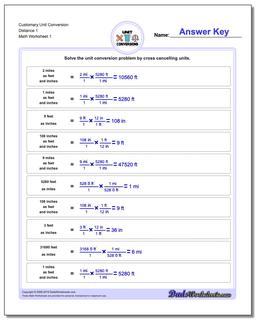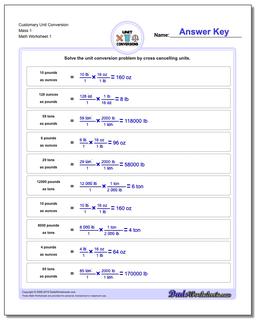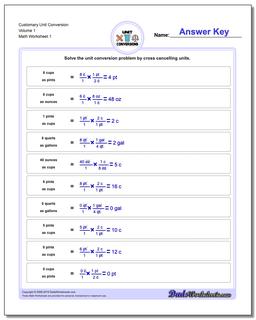Core Math Worksheets
Fraction Worksheets
Algebra
Other Worksheets
Place Value
Percentages
Rounding Numbers
Ordering Numbers
Standard, Expanded, Word Form
Mean Median Mode Range
Ratio Worksheets
Probability Worksheets
Roman Numerals
Factorization, GCD, LCM
Prime and Composite Numbers
Pre-Algebra
Geometry Worksheets
Blank Clocks
Telling Analog Time
Analog Elapsed Time
Greater Than and Less Than
Money
Arithmetic Sequences
Geometric Sequences
Venn Diagram
Graph Worksheets
Measurement & Conversions
Patterns and Puzzles
Color by Number
Holiday & Seasonal
Early Learning
Printables
Calculators
Math Worksheets by Grade
Worksheet News
Customary Unit Conversions
These practice problems convert values within the customary or imperial system using unit fractions and unit cancelling. There are sets of worksheets coverting length, mass and volume conversions. Each worksheet includes an answer key that shows multiple steps where required to convert within the measurement system to practice unit cancelling when solving a conversion problem.
Distance Conversion
16 Customary Unit Conversions Worksheets
Unit conversion worksheets for converting between customary distance units, including inches, feet, yards and miles.
Distance ConversionMass Conversion
16 Customary Unit Conversions Worksheets
Unit conversion worksheets for converting customary mass units, including ounces, pounds and tons.
Mass ConversionVolume Conversion
16 Customary Unit Conversions Worksheets
Unit conversion worksheets for converting customary volume units, including ounces, pints, quarts and gallons.
Volume ConversionCustomary Conversion Worksheet
Even with the standardization of the metric system, customary units of measurement are still widely used, especially in the United States. The customary measurement system is somewhat more complex and requires memorizing a number of important facts to make conversions happen. The worksheets in this section provide plenty of practice converting between customary units of mass, volume and distance.
Inches to Feet (Customary Distance Measurement)
There are several facts that must be memorized to convert between customary units of distance measurements. There are exactly twelve inches in one foot. There are three feet in a yard, which means there are 36 inches in one yard. And there are 5,280 feet in a mile, which (divided by three feet per yard) means there are 1,760 yards in one mile. You can use these facts to convert inches to feet, feet to miles, yards to miles, inches to miles or anything in between.The first set of worksheets in this section deal with these distance conversions, all of which start with inches to feet and feet to inches as their base.
Ounces to Pounds (Customary Mass Conversion)
To convert customary units of mass, you must memorize that there are sixteen ounces per pound, and 2,000 pounds per ton. The ounces unit in customary measurement is not the same as that used for volume. Even though an ounce of water has approximately on ounce of volume, that's more of a coincidence than a fact to be relied on, and other measurements of other substances will show that fluid ounces and mass ounces are not interchangable. The worksheets in this section deal with converting mass units and focus on practice problems like converting ounces to pounds, pounds to tons, ounces to tons and similar conversions.
Ounces to Gallons (Customary Volume Conversion)
Units of volume in the customary measurement system are complex. There are eight ounces to one cup, two cups per pint, two pints per quart and four quarts per gallon. Converting between units that are far apart on this scale requires multiplying a large number of constants, for examples to get fluid ounces to gallons the conversion is (8x2x2x4) = 128 ounces per gallon. Because of the number of small units of measure, converting between customary volume units requires diligence. These worksheets deal with ounces to gallons, quarts to gallons, pints to gallons, gallons to ounces and many of the other variations of volume conversion.



